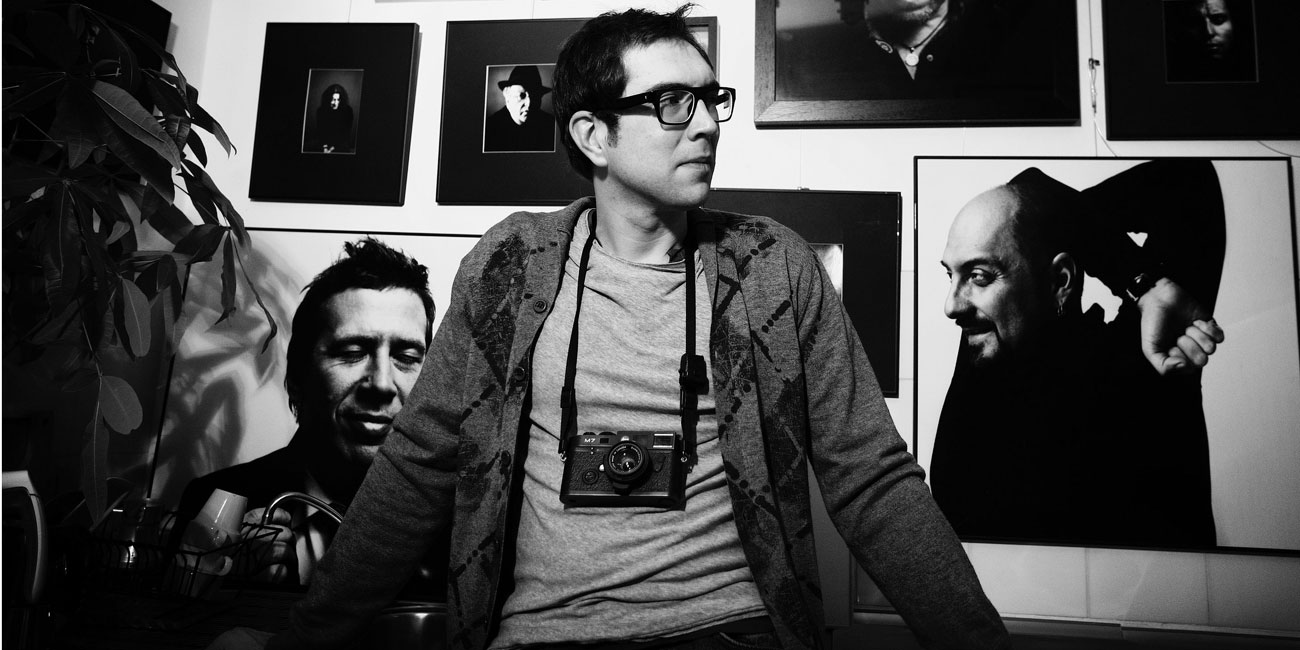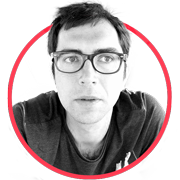
Aleksey Nikishin: “Photography is not an answer. It’s the question”
What is the difference between beauty and harmony, between the professional photographer and the artist? Why compact cameras are worth shooting with? How to train the inner aesthetic sensitivity and what does “iphoneography” mean? Bird In Flight had a talk with Aleksey Nikishin.

37 years oldAleksey Nikishin,
A photographer from Moscow, author of a large scale project “In My Own Role” – the psychological portrait series of famous Russian rock musicians and actors. Nikishin’s photoworks have been displayed in Russia, Europe and the US. He teaches a specialty course “Contemporary photography” at Lomonosov Moscow State University and New York Institute of Photography, as well as photography master-classes. For the past three years he’s been deeply involved into iphonoegraphy.
Website
Like Picasso, try to explore your potential in life. Learn something – then forget it. You can photograph for profit within mastered by you direction, while discovering new frontiers for yourself. An honest artist creates just like he lives. He grows and his photography goes through changes. I have several colleagues whom I greatly respect, but it’s strange to see a 60-year old shoot the same way as he did when he was 30. It shouldn’t be that way: by the time he turned 60 he already lived through two lives, as well as his photography. How can it not change?
When you create art, you should have no limits. Limits come from the society of consumers and their virtue system – it’s the viewer’s problem, not one of the artist’s. Once I tried to take a picture of teens on the beach. I was quickly approached and asked to put the camera away. The Americans explained to me that when I shoot kids in swimsuits I raise suspicion that I might be into child pornography. Americans are very cautious when it comes to child pornography, for them it’s typical. Hurry up and purchase books by Sally Mann before they get banned. Europeans are more open-minded. If someone wants to photograph them – they take it as a compliment. Every European I tried to shoot smiled and behaved uninhibitedly. I did an experiment once: in Fontainebleau, I was shooting people taking photos with the fountains. I stood behind the person taking the photo – capturing part of their back and everyone within the field of his viewfinder. When they noticed me – they laughed. I could literally come up and get into the shot together.
Don’t think too hard about what you’re shooting – portrait, landscape – capture all and everything. Let the critics decide later how to sort it out. If you start thinking: “Here I am shooting a portrait”, you begin to impose limits and contemplate what you may and may not do. In actuality, you can shoot any way you’d like. Cartier-Bresson used to say: “Do not think – shoot”. That doesn’t mean that your camera should be in the non-stop shooting mode – you need to keep changing your angles. Each image has to differentiate from the previous one as this slight change can be what really “makes” the shot.
{
“img”: “/wp-content/uploads/2014/05/alexey-nikishin-iphonography-2.jpg”,
“alt”: “Aleksey Nikishin iphoneography 2”
},
{
“img”: “/wp-content/uploads/2014/05/alexey-nikishin-iphonography-1.jpg”,
“alt”: “Aleksey Nikishin iphoneography 1”
},
{
“img”: “/wp-content/uploads/2014/05/alexey-nikishin-iphonography-12.jpg”,
“alt”: “Aleksey Nikishin iphoneography 12”
},
{
“img”: “/wp-content/uploads/2014/05/alexey-nikishin-iphonography-18.jpg”,
“alt”: “Aleksey Nikishin iphoneography 18”
},
{
“img”: “/wp-content/uploads/2014/05/alexey-nikishin-iphonography-19.jpg”,
“alt”: “Aleksey Nikishin iphoneography 19”
},
{
“img”: “/wp-content/uploads/2014/05/alexey-nikishin-iphonography-17.jpg”,
“alt”: “Aleksey Nikishin iphoneography 17”
}
Don’t try to justify your work. If you feel the shot is well done – let it be. If not sure – come back to it in a year. What’s important is not what you shoot but what you select. A random photo is great, but only when you know how to make the right selection. Amateur photographers follow no clichés and no rules, that’s why they manage to take good pictures: not “beautiful”, yet clear and unrestrained. But nonprofessionals can’t recognize those. Still, a decent curator can compose an excellent exhibition out of their work.
Train your inner “taste for beauty” – check out pieces of art, cinema and photography. You are better off not looking at work of your colleagues – or you fall into repeating the past instead of gazing into the future. Seek amazement – it’s vital for a photographer. As you walk along the street, pay attention to stuff and think “Wow!”. If you keep doing this you won’t be able to avoid good snapshots! Those images that can’t be reproduced carry the highest value.
Beauty as a notion is for mediocre people. For the complicated ones it is harmony that matters the most. Harmony is when everything is in its place within the frame – not just a “pretty child”, “cute dog”, “beautiful woman”. Composition is not defined by simple formulas, it is rather decided on individually within every shot. You can’t use a ruler to measure Helmut Newton’s photos. They are full of interconnected elements. If you take something out and rearrange it, its balance will be disrupted.
{
“img”: “/wp-content/uploads/2014/05/viktor-rizhakov-foto-fotograf-alexey-nikishin.png”,
“alt”: “Victor Ryzhakov photo Aleksey Nikishin”
},
{
“img”: “/wp-content/uploads/2014/05/polina-agureeva-foto-fotograf-alexey-nikishin.png”,
“alt”: “Polina Agureeva photo Aleksey Nikishin”
},
{
“img”: “/wp-content/uploads/2014/05/polina-agureeva-foto-fotograf-alexey-nikishin-3.png”,
“alt”: “Polina Agureeva photo Aleksey Nikishin 3”
},
{
“img”: “/wp-content/uploads/2014/05/kirill-serebrennikov-foto-fotograf-alexey-nikishin.png”,
“alt”: “Kirill Serebrennikov photo Aleksey Nikishin”
},
{
“img”: “/wp-content/uploads/2014/05/chulpan-hamatova-foto-fotograf-alexey-nikishin.png”,
“alt”: “Chulpan Hamatova photo Aleksey Nikishin”
},
{
“img”: “/wp-content/uploads/2014/05/andrey-makarevich-foto-fotograf-alexey-nikishin.png”,
“alt”: “Andrei Makarevich photo Aleksey Nikishin”
}
Portrait is the expression of human individuality, the very thing that sets us apart from each other. Every new portrait has to differ from the previous one. The job of a portraitist is research. If all portraits turn out similar, you need to think about it. Psychological portrait is a discovery about the person you photograph. He came to you for this discovery, not for the photos where he looks like himself. If it was just that, he would have gone to a photo booth. When you make portraits, the most successful ones often turn up either at the beginning of the session or at the very end of it. At the beginning – because the person isn’t yet posing, at the end – because he’s done posing.
My personal opinion – cameras have to be small. In the studio setting a big camera is okay, but on the road – not so much. I managed to return with majority of good pictures only because I had my camera (iPhone – editor’s note) in my pocket. Take it out – and snap! Iphonoegraphy is an art in its purest form. You don’t need to set up and tune up stuff, don’t need to worry about diaphragms and other equipment – all you do is create art. Camera which I rent for cash, – Canon 5D, is six years old, already had to replace its shutter button and the cover. I switched to basic film photography from “digits” – I use cameras Rolleiflex 2.8FX and Leica M7. I like wide angle optics – because the image gets slightly distorted.
How is an amateur different from a professional, and a professional from an artist? An amateur can capture a good shot, but can never predict the result. A professional guarantees the result, because he knows how to achieve it. An artist, in his turn, can’t predict the result because his job is the search for novelty, – a discovery. Who knows ahead of time what it’ll turn out to be? Photography is the question, not the answer. If the shot is fully understood right away, it stops being interesting.
{
“img”: “/wp-content/uploads/2014/05/alexey-nikishin-iphonography-7.png”,
“alt”: “Aleksey Nikishin iphoneography 7”
},
{
“img”: “/wp-content/uploads/2014/05/alexey-nikishin-iphonography-13.png”,
“alt”: “Aleksey Nikishin iphoneography 13”
},
{
“img”: “/wp-content/uploads/2014/05/alexey-nikishin-iphonography-14.png”,
“alt”: “Aleksey Nikishin iphoneography 14”
},
{
“img”: “/wp-content/uploads/2014/05/alexey-nikishin-iphonography-16.png”,
“alt”: “Aleksey Nikishin iphoneography 16”
}
Contemporary photography is one chapter, and contemporary art is a different one. To move up from a photography catalogue into an art catalogue is not easy. Only three out of those who are still alive could accomplish that – Nan Goldin, Juergen Teller and Cindy Sherman. Their photography is not beautiful – it is intelligent. Once you know the context within which the modern artists create, you begin to understand what they photograph and why. And when you gain the understanding of what they all shoot, you will also realize what it is that you yourself want to shoot and how you yourself want to live. Russia doesn’t have contemporary photography. There are several authors who attempt to channel the westerners, but none of the are working with the Russian context. Perhaps it is difficult for them to define it, or maybe they are just shy.
New and best




